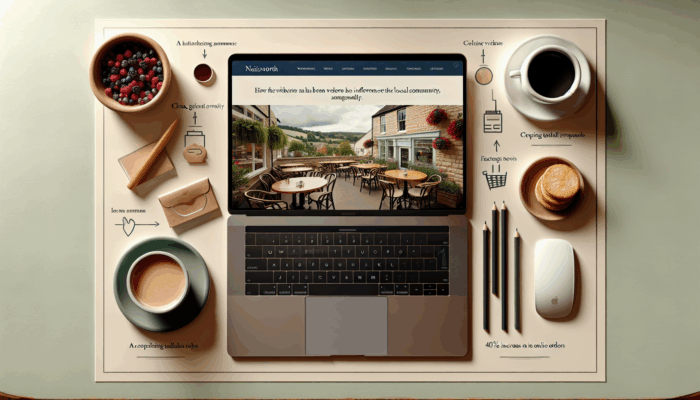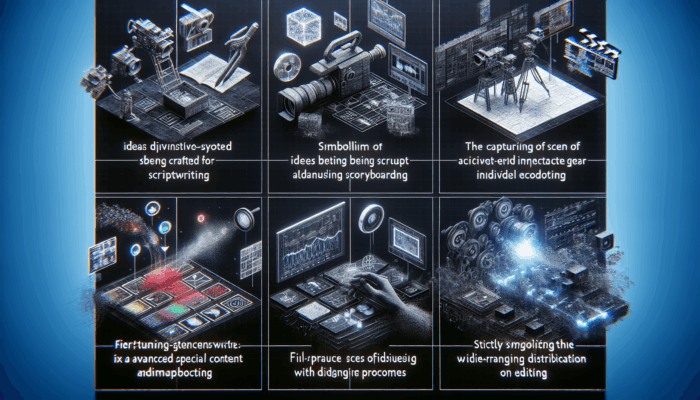Table of Contents
ToggleMaximising Engagement Through the Power of Dynamic Visuals
What Are Dynamic Visuals and Their Importance?

dynamic visuals have emerged as a crucial element in the landscape of contemporary content engagement, renowned for their distinctive capability to present data in real-time. In contrast to traditional static imagery, these visuals create an interactive experience that refreshes automatically as new data becomes available. This dynamic nature significantly enhances user engagement by delivering information in a way that is not only visually appealing but also more comprehensible. For example, a live dashboard that showcases fluctuations in stock market indices or provides real-time weather updates allows users to quickly understand complex datasets, making the information more relatable and user-friendly.
Moreover, the application of Dynamic visuals goes beyond mere aesthetic enhancement; it fundamentally transforms how users engage with content. By integrating real-time data, these visuals meet the increasing demand for immediate information access, which is vital across numerous sectors, including finance, sports, and journalism. Users are naturally more inclined to interact with content that reflects ongoing trends and developments, as this not only prompts engagement but also cultivates a deeper understanding of the topics presented.
Furthermore, the effectiveness of dynamic visuals is significantly amplified when they are meticulously designed with user experience in mind. Well-crafted visuals respond to user interactions, offering a personalised experience that encourages users to delve deeper into the content. This interactivity can increase the duration of time spent on a page and the likelihood of content sharing, ultimately enhancing the visibility and authority of the source.
How to Successfully Integrate Dynamic Visuals into Your Content?
To effectively incorporate dynamic visuals into your content strategy, it is essential to adopt a methodical approach that commences with the selection of the most appropriate tools and platforms. A variety of software solutions and libraries are available, such as D3.js, Tableau, and Google Charts, each offering unique capabilities for visualising real-time data. It is imperative to evaluate these tools based on the specific requirements of your content and the preferences of your target audience for successful integration.
It is also crucial to ensure that the selected tools can proficiently manage real-time data feeds. This includes establishing robust data pipelines that guarantee accurate and timely information is delivered to the visualisation tools. Rigorous testing should be conducted to verify that the visuals not only function smoothly but also maintain a high level of data integrity. A user-friendly interface is another critical consideration during the implementation phase, as it ensures that even individuals with limited technical knowledge can navigate the visuals with ease and extract meaningful insights.
Additionally, it is vital to prioritise the overall user experience. Aspects such as loading times, mobile compatibility, and interactivity must be addressed, as these factors can significantly influence user engagement. By concentrating on user experience, content creators can maximise the effectiveness of the dynamic visuals they implement, ensuring that the content resonates well with their audience and effectively conveys the intended message.
What Are the Advantages of Incorporating Dynamic Visuals?
The integration of dynamic visuals into content offers numerous benefits that greatly enhance user engagement and understanding. One of the most significant advantages is the increase in audience interaction. Dynamic visuals are inherently captivating, motivating users to explore the data in greater depth, thereby fostering a more engaging and interactive experience. This heightened interaction can have positive effects on metrics such as time spent on page and overall user satisfaction.
In addition, dynamic visuals facilitate a deeper understanding of data. By transforming complex datasets into interactive graphics, users can more readily discern patterns and trends that may be obscured in static formats. For instance, an interactive scatter plot that updates with live sales data allows users to identify fluctuations and emerging trends in real-time, providing invaluable insights that inform decision-making processes.
Another notable benefit is the provision of up-to-date information. In an era where data is in constant flux, access to real-time insights ensures that users are equipped with the most current information available. This is particularly critical in sectors such as finance, where reliance on outdated data can lead to poor decision-making. By consistently delivering the latest updates through dynamic visuals, content creators can position themselves as trusted sources, thereby enhancing their authority within their respective fields.
How Are Dynamic Visuals Applied Across Various Industries?

Dynamic visuals serve as versatile tools utilised across a multitude of industries, demonstrating their extensive applicability and effectiveness. For instance, live sports scoreboards epitomise the use of dynamic visuals, keeping fans engaged and informed about ongoing matches. These scoreboards provide real-time updates on scores, player statistics, and game timelines, allowing fans to immerse themselves in the experience, whether they are watching from home or in the stadium.
In the financial sector, stock market tickers exemplify another prime application of dynamic visuals in action. Investors rely on these tickers for immediate updates on market performance, empowering them to make informed trading decisions. The continuous stream of data presented in an easily digestible format enables users to track their investments effectively and respond promptly to market fluctuations.
Interactive weather maps further illustrate how dynamic visuals can substantially enhance user experience. These maps allow users to view real-time weather conditions, forecasts, and alerts, delivering critical information that can influence decisions related to travel, outdoor activities, and personal safety. By integrating such visuals into their content, organisations can provide a valuable service while ensuring users remain informed with the latest updates.
Expert Strategies for Enriching Content with Real-Time Data Visualisations
What Successful Implementations of Dynamic Visuals Exist in the Real World?
A plethora of organisations have adeptly harnessed dynamic visuals to elevate user engagement and comprehension. For instance, The Guardian employs live blogs featuring real-time data visualisations to provide continuous updates on evolving news stories. This method not only keeps the audience engaged but also aids in fostering a comprehensive understanding of the topics discussed. Other noteworthy examples include:
- BBC Sport’s live match coverage featuring interactive scoreboards.
- Bloomberg’s financial dashboards that deliver real-time stock updates.
- The New York Times’ interactive graphics for election coverage.
- National Geographic’s dynamic environmental data visualisations.
The key success factors for these implementations encompass the ability to present data in an engaging manner, ensuring accuracy, and maintaining user focus. These examples highlight the potential for organisations to significantly enhance their content by leveraging real-time data visualisations.
What Steps Can Be Taken for Effective Integration of Dynamic Visuals?

Integrating dynamic visuals into existing content platforms can be a transformative process when approached systematically. The first step involves identifying the specific data to be visualised, ensuring it aligns closely with audience interests and needs. Following this, organisations should select the appropriate tools that facilitate seamless visualisation of this data, such as APIs or data management systems capable of supporting real-time updates.
Once the tools are selected, it is crucial to develop a clear strategy for data sourcing and management. Regular updates and validation checks should be implemented to maintain the accuracy and relevance of the data being presented. Additionally, thorough testing of the visuals across various devices and browsers is essential to ensure they function correctly, thereby optimising the user experience.
- Identify key data points to be visualised.
- Select suitable visualisation tools or platforms.
- Establish a regular schedule for data updates.
- Conduct user testing to assess functionality and design.
Lastly, developing an ongoing feedback mechanism to collect insights from users will support continuous improvements and adjustments to the visuals, enhancing their effectiveness over time. By adhering to these steps, organisations can create compelling content that resonates with audiences through dynamic visuals.
What Expert Analysis Is Available on Future Trends in Dynamic Visuals?
The domain of dynamic visuals is rapidly advancing, with several trends poised to shape the future of real-time data visualisation. A significant trend is the increasing integration of artificial intelligence and machine learning to enhance the capabilities of visualisation tools. These technologies can efficiently analyse vast datasets, identifying patterns and insights that may otherwise go unnoticed, thus improving the overall quality and depth of visualisations.
Moreover, the rise of augmented reality (AR) and virtual reality (VR) applications in data visualisation represents another emerging trend. These technologies provide immersive experiences, allowing users to interact with data in three-dimensional environments. This could revolutionise how users perceive and interpret complex information, particularly in sectors such as education, healthcare, and urban planning.
Furthermore, the demand for mobile-optimised dynamic visuals is growing, as an increasing number of users access content through smartphones and tablets. Ensuring that visuals are responsive and adaptable will be crucial for maintaining user engagement across various devices. As technology continues to evolve, the opportunities for new methodologies and tools to enhance real-time data visualisation will expand, offering exciting possibilities for content creators to effectively engage their audiences.
What Best Practices Ensure Data Accuracy and Integrity in Dynamic Visuals?
Ensuring data accuracy and integrity in dynamic visuals is paramount, as inaccuracies can undermine user trust and engagement. Best practices include implementing regular updates and validation checks to guarantee that the displayed data is current and reliable. This involves monitoring data feeds and verifying the sources from which the data is obtained, ensuring they are trustworthy and reputable.
Utilising automated systems for data collection and visualisation can significantly enhance accuracy, as these systems can swiftly identify and correct errors before they reach users. Regular audits of data processes should also be conducted to pinpoint potential weaknesses and areas for improvement. This proactive approach ensures a high level of data integrity, bolstering user confidence in the information presented.
- Establish a regular update schedule for data feeds.
- Implement validation checks for data sources.
- Utilise automated systems for error detection.
- Conduct regular audits to assess data processes.
By prioritising these best practices, organisations can build a foundation of trust, allowing users to engage with the content confidently, assured that they are receiving accurate and reliable information through dynamic visuals.
What Case Studies Highlight the Success of Dynamic Visuals in Audience Engagement?
Case studies offer invaluable insights into how dynamic visuals can significantly enhance audience engagement. A prime example is the interactive COVID-19 dashboard developed by Johns Hopkins University. This dashboard provided real-time updates on case numbers, highlighting geographical trends and insights. The visualisation emerged as a critical resource for the public, receiving millions of visits and establishing the university as a trusted information source during the pandemic.
Another compelling case is Spotify’s Wrapped feature, which employs dynamic visuals to present personalised data to users at the end of each year. By showcasing individual listening habits through engaging graphics, Spotify not only drives user interaction but also encourages social sharing, significantly boosting its visibility and engagement across platforms.
These examples demonstrate the effectiveness of dynamic visuals in captivating audiences and enhancing their understanding. By presenting information in an interactive format, organisations can weave compelling narratives that resonate with users, ultimately driving greater interaction and satisfaction.
How Can Real-Time Data Add Value to Your Content?
What Types of Content Gain the Most from Real-Time Data Visualisations?
Real-time data visualisations are particularly advantageous for specific content types that require continually updated information. News articles covering breaking events, for instance, derive immense benefit from live updates that keep readers informed. These updates provide context and depth, enabling journalists to craft a more comprehensive narrative as events unfold.
Financial reports also thrive on real-time data, given that fluctuations in stock prices and market conditions can change rapidly. By integrating live financial data, organisations can furnish investors with immediate insights, aiding them in making informed decisions based on the latest market trends. Live event coverage, such as sports or concerts, similarly benefits from real-time updates, enhancing audience engagement by keeping fans informed about ongoing developments.
In the realm of e-commerce, dynamic visuals displaying inventory levels or price changes in real-time can create a sense of urgency, motivating purchases. By illustrating high demand or fluctuating prices, businesses can prompt users to act swiftly, capitalising on immediate purchasing opportunities.
What Are the Technical Requirements for Successful Implementation of Dynamic Visuals?
To effectively harness real-time data visualisations, organisations must meet specific technical prerequisites. Robust data feeds are essential to ensure that the displayed information is accurate and timely. These feeds should be sourced from reliable databases or APIs capable of supporting the volume and velocity of data being processed.
A dependable hosting platform is also crucial, as it must manage the traffic generated by users accessing the dynamic visuals. Scalability should be a key consideration, allowing for adjustments based on user demand and fluctuations in data volume. Additionally, user-friendly visualisation tools are necessary to create engaging and interactive graphics that enhance the user experience.
- Robust data feeds sourced from reliable origins.
- Reliable and scalable hosting platforms.
- User-friendly visualisation tools to facilitate ease of use.
- Regular testing to ensure compatibility across diverse devices.
By ensuring these technical requirements are fulfilled, organisations can optimise the deployment of real-time data visualisations, enhancing the overall effectiveness and engagement of their content.
How Does Real-Time Data Enhance User Engagement?
Utilising real-time data visualisations significantly boosts user engagement by providing live updates that capture and retain audience attention. When users observe information updating in real-time, it fosters a sense of immediacy and relevance, compelling them to remain on the page longer and explore further. This can result in increased time spent on-site and improved metrics across various platforms.
Moreover, dynamic visuals encourage users to actively interact with the content. For example, interactive charts that allow users to filter data or adjust parameters enrich the user experience by enabling personal exploration of the information. This interactivity not only keeps users engaged but also nurtures a deeper understanding of the content being presented.
As users engage with real-time data visualisations, they are more likely to share their experiences on social media or recommend the content to others, amplifying the reach and visibility of the original content. This organic sharing can lead to increased website traffic and a broader audience base, further establishing the organisation as a credible and engaging source of information.
Proven Techniques for Enhancing Content with Real-Time Data Visualisations
What Best Practices Ensure Data Accuracy in Dynamic Visuals?
Data accuracy is imperative when dealing with dynamic visuals, as inaccuracies can lead to misinformation and erode user trust. Best practices for ensuring data accuracy include establishing a regular update schedule that allows for timely refreshes of the data being displayed. This approach guarantees that users are consistently presented with the most relevant and accurate information.
Additionally, conducting validation checks on data sources is critical. Ensuring that all data originates from trusted and reputable sources mitigates the risk of inaccuracies and enhances the overall integrity of the visuals. Implementing automated systems for data extraction and processing can further bolster accuracy, as these systems can quickly identify and rectify errors before they reach the end user.
- Establish a regular update schedule to maintain accuracy.
- Conduct validation checks on data sources.
- Implement automated systems for data processing.
- Monitor data feeds for anomalies and errors.
By adhering to these best practices, organisations can cultivate user trust and engagement, ensuring that their dynamic visuals serve as reliable sources of information.
How to Choose the Right Tools for Dynamic Visuals?
Selecting the appropriate tools for dynamic visuals requires a careful evaluation of specific data types, audience needs, and desired levels of interactivity. A plethora of tools exists, each offering unique features and capabilities. For instance, tools like Tableau and Power BI provide powerful data integration and visualisation options, while libraries such as D3.js offer extensive customisation capabilities for developers.
Consideration should also be given to the skill level of the team involved in the implementation. User-friendly platforms that require minimal technical expertise can expedite the integration process and reduce the learning curve for content creators. Furthermore, flexibility and scalability are crucial factors, as the chosen tools should accommodate future data needs and growth.
- Assess the type of data to be visualised.
- Determine audience preferences and needs.
- Evaluate the skill level of the implementation team.
- Prioritise flexibility and scalability in tool choice.
By carefully considering these factors, organisations can select the right visualisation tools that align with their goals and deliver impactful dynamic visuals that enhance user engagement and understanding.
What Strategies Ensure a Consistent Flow of Real-Time Data?
Maintaining a consistent flow of real-time data is essential for ensuring that dynamic visuals continue to effectively engage users. Efficient data management systems play a pivotal role in achieving this objective. These systems should be designed to handle substantial data volumes while ensuring accuracy and rapid processing speeds. Implementing robust data pipelines that can ingest, process, and deliver data to visualisation tools in real-time is crucial.
Additionally, establishing contingency plans to address potential disruptions in data flow is prudent. This may involve backup data sources or alternative visualisation methods that can be deployed in the event of technical failures. Regular monitoring of data feeds is also vital to swiftly identify and rectify issues, ensuring that users have uninterrupted access to current information.
- Implement efficient data management systems.
- Establish robust data pipelines for real-time delivery.
- Create contingency plans for potential disruptions.
- Monitor data feeds for performance and reliability.
By focusing on these strategies, organisations can enhance the reliability of their dynamic visuals, providing users with continuous access to the latest information and maintaining high levels of engagement.
What Challenges Are Associated with Real-Time Data Visualisation?
How Can Technical Barriers Be Addressed Effectively?
Addressing the technical challenges related to real-time data visualisation necessitates strategic planning and resource allocation. Common obstacles such as data latency, system scalability, and integration issues must be tackled to ensure seamless operation. Choosing scalable platforms is vital; they should be equipped to handle fluctuating data volumes and user traffic without compromising performance.
Implementing robust data pipelines can help mitigate latency problems. These pipelines should be designed to facilitate rapid data processing and delivery, ensuring that updates are reflected in the visuals as they occur. Utilising cloud-based solutions can further enhance scalability and performance, offering flexibility in resource allocation while alleviating the load on local servers.
Moreover, regular testing and optimisation of the visualisation tools are imperative. This includes evaluating the systems under varying loads and making necessary adjustments to configurations to guarantee optimal performance. By addressing these technical barriers, organisations can enhance the effectiveness of their dynamic visuals, delivering a seamless experience to users.
What Common Data Integrity Issues Can Arise?
Data integrity issues in real-time visualisation can stem from various sources, such as corrupted data feeds, incorrect data processing, or outdated information being displayed. Such issues can lead to significant discrepancies in the information presented, ultimately undermining user trust and engagement. Regular audits of data sources and processes are essential to identify and rectify potential integrity issues before they affect users.
Implementing robust validation checks can significantly reduce the likelihood of errors. These checks should verify data accuracy at multiple stages of processing, ensuring that only reliable information is visualised. Additionally, maintaining transparency with users regarding data sources and update frequencies allows them to understand the context of the information presented.
- Conduct regular audits of data sources and processes.
- Implement validation checks for data accuracy.
- Communicate transparently about data update frequencies.
- Monitor for potential data discrepancies and rectify promptly.
By addressing these common data integrity issues, organisations can reinforce the reliability of their dynamic visuals, ensuring that users receive accurate and trustworthy information.
How Can User Expectations Be Effectively Managed?
Managing user expectations is a critical aspect of implementing real-time data visualisations. Clear communication regarding data update frequencies and potential delays is essential to ensure that users comprehend the nature of the visualisations they are engaging with. Setting realistic expectations helps mitigate frustration and enhances user satisfaction.
Providing users with insights into how often the data is updated can empower them to interact more effectively with the content. For instance, informing users that stock prices refresh every minute or weather conditions update hourly enables them to plan their interactions accordingly. Additionally, offering notifications or alerts for significant changes in data can further enhance user engagement, providing timely information that keeps users informed.
- Clearly communicate data update frequencies.
- Set realistic expectations regarding potential delays.
- Provide insights into the updating process.
- Offer notifications for significant data changes.
By effectively managing user expectations, organisations can enrich the overall experience associated with dynamic visuals, fostering greater engagement and satisfaction.
Maximising the Impact of Real-Time Visuals
What Techniques Can Enhance the Visual Appeal of Dynamic Visuals?
To maximise the impact of dynamic visuals, organisations must concentrate on enhancing visual appeal. The choice of colour schemes plays a pivotal role in user engagement; colours can attract attention and convey meaning. For instance, employing contrasting colours can highlight essential metrics, while a cohesive colour palette can foster a more visually appealing experience.
Incorporating interactive features such as hover effects, clickable segments, or filters can significantly boost user engagement. These elements encourage users to delve deeper into the data, providing opportunities for more profound interaction and understanding. Additionally, ensuring that visuals are clear and easy to interpret is crucial; cluttered or overly complex designs can deter users from engaging with the content.
Furthermore, considering accessibility in design is vital to ensure that diverse audiences can engage effectively with the visuals. This includes using legible fonts, providing alternative text for images, and ensuring that colour contrasts meet accessibility standards. By focusing on these techniques, organisations can create dynamic visuals that are not only visually appealing but also functional and engaging for all users.
What Key Metrics Should Be Monitored to Assess Engagement with Dynamic Visuals?
Monitoring key metrics associated with dynamic visuals is essential for optimising content strategies. User engagement time is a crucial metric, indicating how long users interact with the visualisations. Longer engagement times typically correlate with heightened interest and understanding, underscoring the effectiveness of the visuals.
Another significant metric is the frequency of data updates. Tracking how often data is refreshed can provide insights into user expectations and inform strategies for maintaining engagement. User interaction rates, such as clicks on interactive elements or shares on social media, are also critical indicators, reflecting the effectiveness of the visuals in capturing audience attention.
- User engagement time on visuals.
- Frequency of data updates.
- User interaction rates with the visuals.
- Social media shares and mentions.
By continuously monitoring these metrics, organisations can refine their approaches to creating dynamic visuals, ensuring that they resonate with users and enhance overall content engagement.
What Strategies Support Continuous Improvement of Dynamic Visuals?
Continuous improvement is vital for maximising the effectiveness of dynamic visuals. Regularly collecting feedback from users can yield valuable insights into their experiences and preferences. This feedback should be analysed to identify trends and areas for enhancement, informing iterative updates to the visuals.
Data analysis plays a crucial role in this process. By examining user interactions and engagement metrics, organisations can discern which visual elements are successful and which may require refinement. This data-driven approach allows for targeted improvements that enhance user satisfaction and engagement.
Moreover, staying informed about advancements in technology and design trends can inspire new ideas for visualisation. Incorporating innovative features and methodologies can keep the visuals relevant and engaging. By emphasising a culture of continuous improvement, organisations can ensure that their dynamic visuals remain effective and appealing to users over time.
How to Seamlessly Integrate Real-Time Data into Dynamic Visuals?
Integrating real-time data into dynamic visuals is essential for ensuring that users receive the most current information available, significantly enhancing their engagement and satisfaction. This process begins with establishing reliable data sources that can provide consistent updates. Ensuring that these data feeds are robust and capable of accommodating user demand is critical for maintaining the visual’s effectiveness.
Once the data sources are established, organisations must focus on seamless integration with visualisation tools. This involves configuring data pipelines that can process and deliver updates efficiently. Regular monitoring of the integration process is also essential to identify any potential issues that could disrupt the flow of real-time data.
Moreover, providing users with context about the displayed data can enhance their understanding and engagement. For instance, incorporating explanatory text or tooltips alongside the visuals can assist users in interpreting the information more effectively. By prioritising these elements, organisations can create dynamic visuals that not only look appealing but also furnish users with valuable, real-time insights.
What Best Practices Should Be Followed for Real-Time Visualisation Tools?
Adopting best practices for real-time visualisation tools is essential to ensure optimal performance and user satisfaction. Firstly, selecting tools that support real-time data integration is crucial. These tools should be capable of processing large datasets while efficiently rendering visuals without lag or delay.
Ensuring scalability is another critical consideration. As user engagement increases, the chosen tools must accommodate rises in data volume and user traffic without sacrificing performance. Regular updates and maintenance of the tools are also necessary to keep them functioning optimally and to incorporate new features and improvements.
- Select tools that support real-time data integration.
- Ensure scalability for growing user demand.
- Regularly update and maintain visualisation tools.
- Train team members on effective use of the tools.
By adhering to these best practices, organisations can maximise the effectiveness of their dynamic visuals, enhancing user engagement and creating a compelling content experience.
FAQs Regarding Dynamic Visuals
What Are Dynamic Visuals?
Dynamic visuals are real-time data representations that automatically update, providing an engaging method to display information while enhancing user interaction and understanding.
How Can I Implement Dynamic Visuals?
Effective implementation involves selecting the right tools, establishing robust data feeds, and ensuring user-friendly designs to maintain data integrity and enhance user experience.
What Benefits Do Dynamic Visuals Provide?
Dynamic visuals enhance user engagement, improve data comprehension, and deliver up-to-date information, making them indispensable for content enhancement.
Which Types of Content Benefit Most from Real-Time Data Visualisations?
Content such as news articles, financial reports, and live event coverage are most enhanced by real-time data, as they require ongoing updates to keep audiences informed.
How Can I Ensure Data Accuracy in Visualisations?
Ensuring data accuracy involves regular updates, validation checks of data sources, and implementing automated systems for error detection to uphold data integrity.
What Common Challenges Are Associated with Real-Time Data Visualisation?
Common challenges include technical barriers like data latency, data integrity issues, and managing user expectations regarding update frequencies and potential delays.
How Can I Enhance the Visual Appeal of Dynamic Visuals?
Enhancing visual appeal involves selecting suitable colour schemes, incorporating interactive elements, and ensuring clarity and accessibility for all users.
What Strategies Should I Use for Continuous Improvement of Dynamic Visuals?
Strategies include consistently collecting user feedback, analysing engagement metrics, and staying updated on technology trends to guide iterative updates of visuals.
How Do I Manage User Expectations with Real-Time Data?
Managing user expectations necessitates clear communication about data update frequencies, setting realistic expectations for potential delays, and providing insights into the updating process.
What Best Practices Exist for Using Real-Time Visualisation Tools?
Best practices include choosing tools that support real-time integration, ensuring scalability, regularly updating and maintaining tools, and training team members on effective usage.
Connect with Us on Facebook!
The post Enhance Content With Real-Time Data Visualizations: appeared first on Ezi Gold.
















